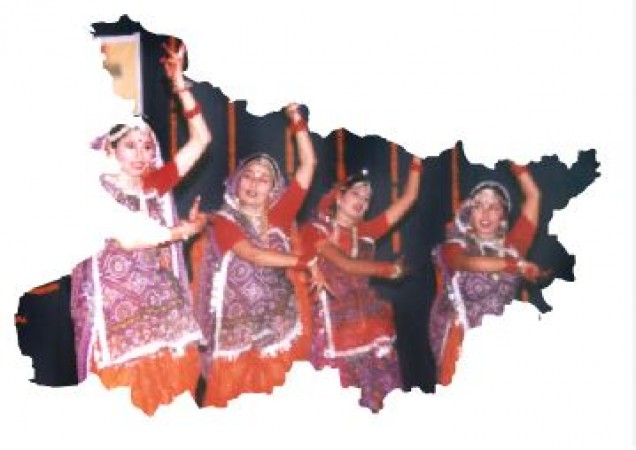
Bihar, a state in eastern India, has a rich cultural heritage, and folk dances play a significant role in its traditional celebrations and festivals. Some of the prominent folk dances of Bihar are:
Jats and Jatin Dance
It is the famous folk dance practiced. It is performed by the women of the Mithilanchal region. The dance is performed on moonlit nights where the dance shows the love story and the separation of lovers ‘Jat’ and ‘Jatin’. Jat-Jatin is most popular in North Bihar, especially in the Mithila and Kosi region. The dance also enacts and reflects on several social issues like droughts, floods, love, sorrow and poverty. The dance depicts a married couple’s sensitive love and dispute. The story shows the love between couples and how Jat and Jatin were very much in love but had to live separately due to bad conditions. It is mostly performed in moonlight in the monsoon season. The women and pairs dance from midnight to dawn and are usually performed by two people.
Also Read: Swan Markers: Exploring the Cultural Significance of Swans in Various Countries
Jhumar Dance
It is a traditional folk dance of Bihar, which is performed by the rural women. There is no fixed season for this beautiful dance form; it is a dance, which is performed at all times. Spring descends on earth with its beauty and spreads joy and happiness all around. The women dance with gay abandon. The men folk are invited to join in and they usually provide the musical accompaniment.
Also Read: Folk Dance of France: Vibrant Rhythms and Elegance
Bidesia Dance
It is a unique form of folk theater and dance prevalent in the Bhojpuri-speaking regions of Bihar. The theme of this dance is social issues, contradictory topics like rich and poor, upper class and lower class and conflict between the traditional and modern lifestyle. This dance form started as a folk theatre play by Bhikari Thakur, a barber by profession. Bhikari Thakur was a well-known playwright and artist of his time and was also referred to as the ‘Shakespeare of Bhojpuri’. He used dance to showcase his views and did it in a sarcastic and entertaining manner which soon became very popular among locals. The Biraha songs used in this dance tell us about the struggle of women who were left behind by their husbands. It gives a clear picture of how women were treated. The female roles in this dance are enacted by male artists with the help of costumes and artificial long hairs.
Also Read: Indian Folk Music: A Melodic Tapestry of Tradition and Culture
Jhijhiya Dance
This folk dance form is a type of prayer dance that stemmed in the Koshi region of Bihar. This is a ritualistic dance performed when there is total drought and the land becomes dry and cracked. This dance form is often performed by women only. It also includes a lead singer, harmonium player, a flutist and a person who plays dholak. Through this dance, people pray and appease Lord Indra, the Lord of rain hoping for a good and life- giving rain as it is crucial and important for agriculture. Along with the dance, the people sing songs that show their conviction and devotion to Lord Indra for a healthy harvest and crops.
Also Read:Exploring the Enigmatic Amazon River: A Journey Through Nature's Wonderland
Paika Dance
This type of traditional folk dance is performed by the Paika community, a warrior class of Orissa. The dance is also performed by the ‘Munda’ and the ‘Oraon’ tribes. Paika is a type of martial or war dance which includes acrobatic and martial arts movements and is usually accompanied by a dhol and a pepa, which is a type of trumpet. This dance form showcases agility, courage, and excitement. The dancers have weapons with them while dancing; they hold wooden shields and swords in their hands while they engage in fierce combat as part of their performance. This dance is used to demonstrate the physical strength of the performers and is performed during festivals and ceremonies. The performers also wear tight dhotis and colorful turbans.
Also Read: Spain's Enchanting Folk Art: A Mosaic of Cultural Heritage
Chhau Dance
Another famous and renowned traditional folk dance of Bihar is Chhau, meaning ‘mask’. The word Chhau is inspired from the Sanskrit word ‘Chhaya’ which means shade. The dance is a combination of martial arts, acrobatics and storytelling and is performed by men. Chhau is typically performed during auspicious occasions and festivals and is accompanied by a dhol. The dancers wear colorful costumes and masks. There are three types of Chhau which are performed in the respective regions with different styles, masks and costumes – Seraikella Chhau, Mayurbhanj Chhau and Purulia Chhau. The Seraikella Chhau is known for its elegant and graceful movements, the Mayurbhanj Chhau is known for its energetic and powerful movements while the Purulia Chhau is known for its elaborate masks and costumes and its way of storytelling. The Chhau dancers hold swords and shields when they perform. Chhau is being recognized as a UNESCO Intangible Cultural Heritage of Humanity as an effort to preserve and promote this traditional dance form.
Also Read:The Dancing Plague of 1518: When Hundreds of People Couldn't Stop Dancing